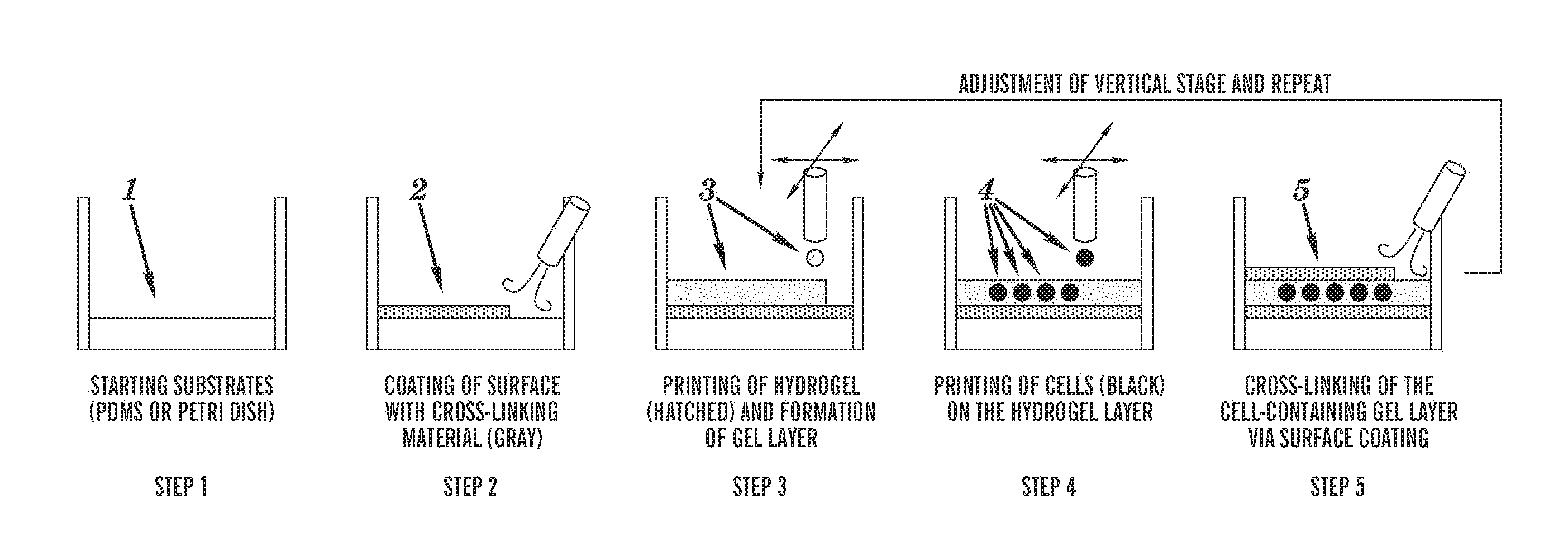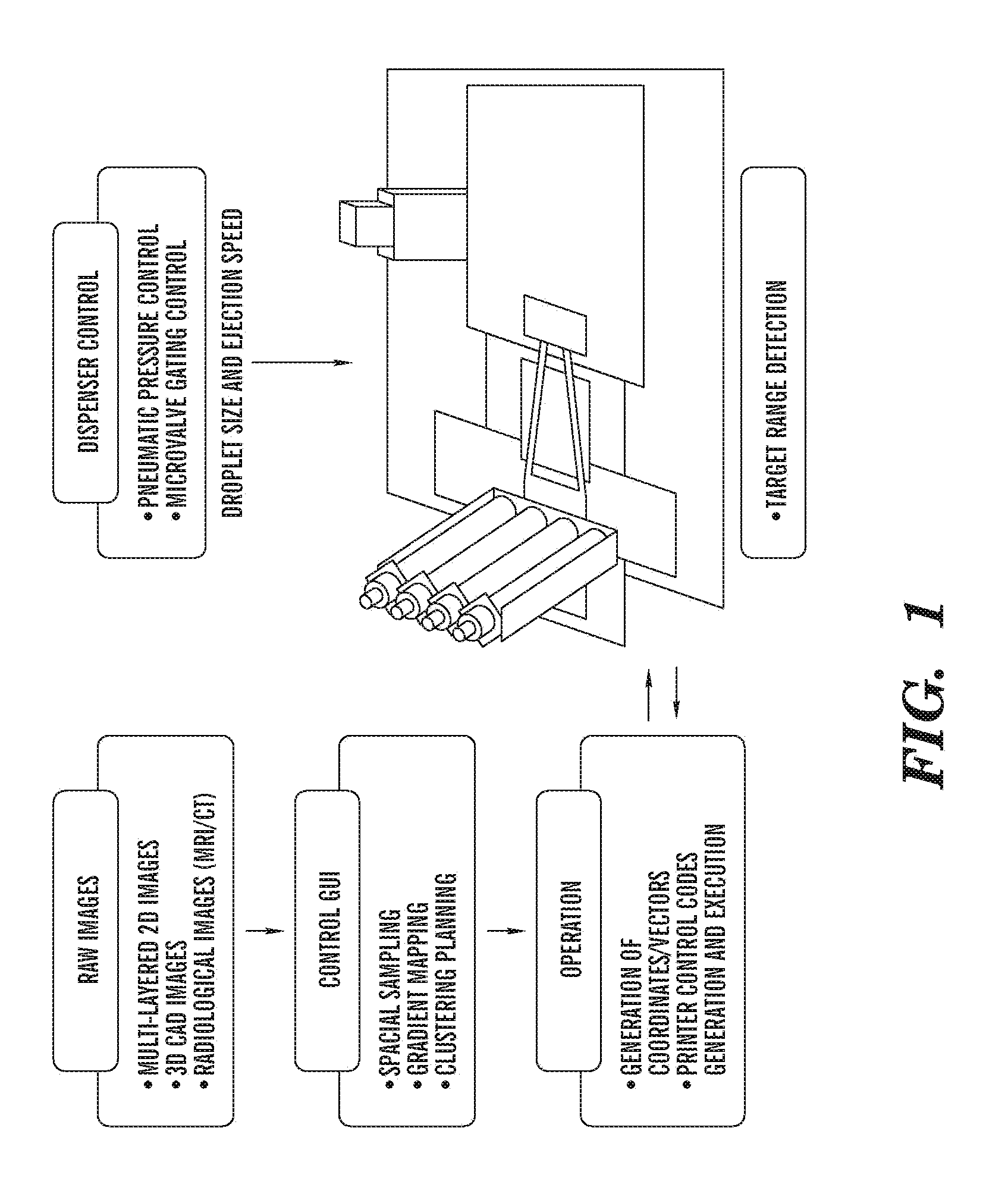3-dimensional multi-layered hydrogels and methods of making the same
a multi-layered hydrogel and multi-layer technology, applied in the field of 3-dimensional multi-layered hydrogels and methods of making the same, can solve the problems of te still facing major constraints, te methods have not been able to engineer replacement tissues that reproduce similar stratifications, and the adherence of cells to polymerized matrices remains problemati
- Summary
- Abstract
- Description
- Claims
- Application Information
AI Technical Summary
Benefits of technology
Problems solved by technology
Method used
Image
Examples
example 1
Constructing Multi-layered Cell-Hydrogel Composites
[0182]To construct multi-layered cell-hydrogel composites, the dispensed hydrogel precursors (in a liquid state) must be cross-linked to form a hydrogel layer before printing any subsequent layers (wherein cells can be present or absent). The dispensing of hydrogel precursors and cross-linking agents on the same location, as a liquid droplet, does not generate the desired printing pattern since two liquid drops, when placed in proximity, immediately form a single drop due to the surface tension; thereby distorting the intended morphology of the tissue constructs. The problem worsens when large size of droplets (depending on the viscosity of the material, in the order of exceeding 100 μm is diameter) is used for patterning. The solution designed by Boland and colleagues (Biotechnology journal 2006, 1:910-917) is to ‘dip’ the printed hydrogel pattern (sodium alginate) into the cross-linking solution (containing calcium chloride) to ma...
example 2
Testing of Printing Resolutions and Patterning
[0187]Prior to 3D multi-layered cell-hydrogel printing, the growth tendencies of printed hFB in the collagen hydrogel are monitored through bright field microscopy. Six different printing resolutions (in terms of inter-dispensing distance) of 200, 300, 400, 500, 700 and 900 μm are examined for printing hFB in the collagen hydrogel. The hFB suspension (concentration of 1×106 cells / mL) is printed in the upper layer of two collagen layers and the growth tendency is monitored on culture day of 1 and 8. With printing resolution of 300 μm, the hFB reached cell confluency within 10 days after printing; therefore, the printing resolution of 300 μm is selected for subsequent 3D printing experiments. To confirm the reliability of on-demand 2D printing, a ‘plus’ shaped hFB pattern, consisting of 5 mm length of vertical and horizontal lines, is printed.
[0188]The hFBs printed at different spatial resolutions were observed under bright field microscop...
example 3
On-Demand Planar Multi-Layer Printing of hFB and hKC
[0189]FIGS. 6A-C show confocal microscope images of printed multi-layer hFB and hKC at Day 4 of culture after immunostaining. Imaging software (Nikon EX-C 1) was used to alternate the presence of each fluorescent dye in the image (FIG. 6A with volume rendered sample). Nuclei, keratin and β-tubulin were differently labeled. FIG. 6B shows the keratin-containing hKC layer with spherical morphology. FIG. 6C (labeling for β-tubulin) illustrates both bottom and upper cell layers contain β-tubulin. hFB layer, approximately 100 μm below the surface of the culture media, shows extensive tree-like morphology which is common in a 3D culture environment (Toriseva M J, et. al., J Invest Dermatol., 2007, 127:49-59). The clear distinctive layers of hFB and hKC were visible under the projection images in FIG. 6B and C. The inter layer distance of approximately 75 μm was observed, indicating that each collagen layer occupied about 15-25 μm (5 layer...
PUM
 Login to View More
Login to View More Abstract
Description
Claims
Application Information
 Login to View More
Login to View More - R&D
- Intellectual Property
- Life Sciences
- Materials
- Tech Scout
- Unparalleled Data Quality
- Higher Quality Content
- 60% Fewer Hallucinations
Browse by: Latest US Patents, China's latest patents, Technical Efficacy Thesaurus, Application Domain, Technology Topic, Popular Technical Reports.
© 2025 PatSnap. All rights reserved.Legal|Privacy policy|Modern Slavery Act Transparency Statement|Sitemap|About US| Contact US: help@patsnap.com



